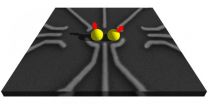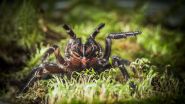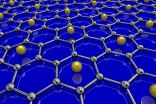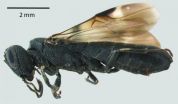(Press-News.org) WORCESTER, MA -- Researchers at the University of Massachusetts Medical School are the first to show that it's possible to reverse the behavior of an animal by flipping a switch in neuronal communication. The research, published in PLOS Biology, provides a new approach for studying the neural circuits that govern behavior and has important implications for how scientists think about neural connectomes.
New technologies have fueled the quest to map all the neural connections in the brain to understand how these networks processes information and control behavior. The human brain consists of 1011 neurons that make 1015 connections. The total length of neuronal processes in the human brain is approximately 4 million miles long, similar in length to the total number of roads in the U.S. Along these networks neurons communicate with each other through excitatory and inhibitory synapses that turn neurons on or off.
The neuronal roadmap, or connectome, however, doesn't include information about the activity of neurons or the signals they transmit. How stable are these neural circuits in the brain? Does their wiring constrain the flow of information or the behaviors they control? The complexity of the human brain makes it almost impossible to address these questions.
Mark Alkema, PhD, associate professor of neurobiology at UMass Medical School turned to the nematode C. elegans to find answers. A tiny worm with only 302 neurons, it is the only animal for which its neural road map has been completely defined.
In this study, Alkema and colleagues sought to determine if flipping the sign of a synapse from inhibitory to excitatory in the worm's brain was enough to reverse a behavior. To do this, they analyzed nematode touch response which C. elegans employ to escape from carnivorous fungi that use hyphal nooses to catch nematodes. During this response neurotransmitters are released that activate an inhibitory ion channel. This causes the worm to relax its head and quickly reverse direction away from the predator.
Jenn Pirri, a doctoral student in the Alkema lab and Diego Rayes, PhD, a former post-doctoral fellow now at the Instituto de Investigaciones Bioquímicas de Bahía Blanca in Argentina, replaced the inhibitory ion channel with an excitatory version of the channel in a live nematode.
"Surprisingly, the engineered channel does not affect development of and is properly incorporated into the neural circuits of the worm brain," said Dr. Alkema. "Cells that are normally inhibited in the brain now get activated.
"What was most striking is that we were able to completely reverse behavior by simply switching the sign of a synapse in the neural network," explained Alkema. "Now the animal contracts its head and tends to move forward in response to touch. This suggests that the neural wiring diagram is remarkably stable and allows these types of changes.
"Our studies indicate that switching the sign of a synapse not only provides a novel synthetic mechanism to flip behavioral output but could even be an evolutionary mechanism to change behavior," said Alkema. "As we start to unravel the complexity and design of the neural network, it holds great promise as a novel mechanism to test circuit function or even design new neural circuits in vivo."
INFORMATION:
About the University of Massachusetts Medical School
The University of Massachusetts Medical School, one of the fastest growing academic health centers in the country, has built a reputation as a world-class research institution, consistently producing noteworthy advances in clinical and basic research. The Medical School attracts more than $240 million in research funding annually, 80 percent of which comes from federal funding sources. The mission of the Medical School is to advance the health and well-being of the people of the commonwealth and the world through pioneering education, research, public service and health care delivery with its clinical partner, UMass Memorial Health Care. For more information, visit http://www.umassmed.edu.
SALT LAKE CITY, Sept. 7, 2015 - If you are in a special relationship with another person, thank grandma - not just yours, but all grandmothers since humans evolved.
University of Utah anthropologist Kristen Hawkes is known for the "grandmother hypothesis," which credits prehistoric grandmothering for our long human lifespan. Now, Hawkes has used computer simulations to link grandmothering and longevity to a surplus of older fertile men and, in turn, to the male tendency to guard a female mate from the competition and form a "pair bond" with her instead of mating with ...
Physicists from the Department of Nanophotonics and Metamaterials at ITMO University have experimentally demonstrated the feasibility of designing an optical analog of a transistor based on a single silicon nanoparticle. Because transistors are some of the most fundamental components of computing circuits, the results of the study have crucial importance for the development of optical computers, where transistors must be very small and ultrafast at the same time. The study was published in the scientific journal Nano Letters.
The performance of modern computers, which ...
Developing transparent or semitransparent solar cells with high efficiency and low cost to replace the existing opaque and expensive silicon-based solar panels has become increasingly important due to the increasing demands of the building integrated photovoltaics (BIPVs) systems. The Department of Applied Physics of The Hong Kong Polytechnic University (PolyU) has successfully developed efficient and low-cost semitransparent perovskite solar cells with graphene electrodes. The power conversion efficiencies (PCEs) of this novel invention are around 12% when they are illuminated ...
Calculation with electron spins in a quantum computer assumes that the spin states last for a sufficient period of time. Physicists at the University of Basel and the Swiss Nanoscience Institute have now demonstrated that electron exchange in quantum dots fundamentally limits the stability of this information. Control of this exchange process paves the way for further progress in the coherence of the fragile quantum states. The report from the Basel-based researchers appears in the scientific journal Physical Review Letters.
The basic idea of a quantum computer is to ...
DENVER, Colo. -- The International Association for the Study of Lung Cancer (IASLC) today issued a new statement on Tobacco Control and Smoking Cessation at the 16th World Conference on Lung Cancer (WCLC) in Denver. The statement calls for higher taxes on tobacco products, comprehensive advertising and promotion bans of all tobacco products and product regulation including pack warnings.
"Tax policies that increased the cost of cigarettes have played a prominent role in the reduction of cigarette smoking," said Dr. Kenneth Michael Cummings, Professor, Hollings Cancer ...
Scientists studying funnel-web spiders at Booderee National Park near Jervis Bay on the New South Wales south coast have found a large example of an unexpected funnel-web species.
The scientists believe the 50-millimetre spider is a species of the tree-dwelling genus Hadronyche, not the ground-dwelling genus Atrax, which includes the Sydney funnel-web, the only species reported in the Park's records.
"It's remarkable that we have found this other species in Booderee National Park," said Dr Thomas Wallenius, from The Australian National University (ANU).
"It shows ...
Graphene, the ultra-thin, ultra-strong material made from a single layer of carbon atoms, just got a little more extreme. University of British Columbia (UBC) physicists have been able to create the first ever superconducting graphene sample by coating it with lithium atoms.
Although superconductivity has already been observed in intercalated bulk graphite--three-dimensional crystals layered with alkali metal atoms, based on the graphite used in pencils--inducing superconductivity in single-layer graphene has until now eluded scientists.
"This first experimental realization ...
Social network Flickr and citizen science website BugGuide have helped scientists to expand the known range of a rarely collected parasitic woodwasp, native to the eastern United States. Partially thanks to the two online photograph platforms, now the species' distribution now stretches hundreds of miles west of previous records. Previously known from only 50 specimens mainly from the Northeast, now the species was discovered in the Ozark Mountains by researchers from the University of Arkansas. Their study is published it in the open access journal Biodiversity Data Journal.
Spurred ...
[Basel, Switzerland - 8 September 2015] The Drugs for Neglected Diseases initiative (DNDi) has announced today at the 9th European Congress on Tropical Medicine and International Health (ECTMIH) in Basel, Switzerland, the successful completion of Phase I human clinical trials for SCYX-7158 (AN5568), the first oral drug candidate specifically developed from the earliest drug discovery stage to combat human African trypanosomiasis, or sleeping sickness, a deadly parasitic disease transmitted by the tsetse fly.
The Phase I study, conducted in France, assessed the safety, ...
Edible dormice (Glis glis) spend about eight months on average in hibernation. Wildlife biologists from the Research Institute of Wildlife Ecology of the Vetmeduni Vienna have shown for the first time that these animals can hibernate for up to 11.4 months. "This may be a world record," says Claudia Bieber, co-author of the study. "Dormice in our climate zone don't just spend the winter months underground, they sometimes begin hibernating in summer."
The animals do not hibernate for so long every year, but only in years when beech trees produce few beechnuts. Successful ...





